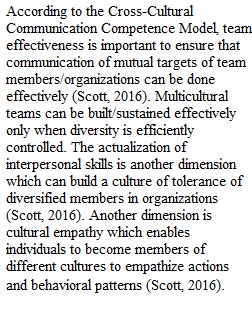


Q When preparing for your discussion post on this case, it is recommended that you read through it several times. Read through it the first time to familiarize yourself with the prompt. On the second reading, consider your assigned role in the situation, and let that guide your perspective. Look deeper at the details: facts, problems, organizational goals, objectives, policies, strategies. Next, consider the concepts, theories, tools and research you need to use to address the issues presented. Then, complete any research, analysis, calculations, or graphing to support your decisions and make recommendations. In this module, you covered the role that culture can play in international business operations. One way to assess potential impacts that culture can have on an organization is through a review of the Cross-cultural Communication Competence Model that includes four dimensions: interpersonal skills, team effectiveness, cultural uncertainty, and cultural empathy (Scott, 2016). In addition to this week’s textbook readings, the article, Cross culture management: Global healthcare workers (Links to an external site.) (Scott, 2016), should be utilized in this module’s discussion forum. You have just been selected by the World Health Organization to take a team of medical personnel, including doctors, nurses, and technicians into South Sudan to start a children’s hospital. Your team consists of personnel from the United States, Japan, Germany, and Brazil. None of your team has worked together before. You decide to provide your team training on the Cross-Cultural Communication Competence Model developed by Mateev and Nelson (Scott, 2016). A. Answer the following questions: 1. Read the article about the Cross-Cultural Communication Competence Model and provide a brief overview of the key aspects of each of the Cross-Cultural Communication Competence Model’s four dimensions and how the model was applied. 2. Discuss any weaknesses that the model has and what you recommend adding to the model to improve it. 3. Discuss what you believe your biggest challenge would be to get your team to work together and open a successful children’s hospital. How would you overcome this challenge? Explain how you will use key aspects of the model to develop training for the team. 4. How does the political environment of each country impact how you approach the management style you utilize for your team? B. When responding to at least two classmates, consider the weakness they addressed in the model. Explain how the weakness they highlighted could be an opportunity. Ensure you support your responses with scholarly reference material using APA formatting. REFERENCES Scott, K. (2016). Cross culture management: Global healthcare workers (Links to an external site.). Journal of Continuing Education Topics and Issues, 18(3), 68-75. Retrieved from http://www.academia.edu/18163325/Cross_Culture_Management_Global_Healthcare_Workers (Links to an external site.) Consult the Discussion Posting Guide for information about writing your discussion posts. It is recommended that you write your post in a document first. Check your work and correct any spelling or grammatical errors. When you are ready to make your initial post, click "Reply." Then copy/paste the text into the message field, and click "Post Reply." To respond to a peer, click “Reply” beneath her or his post and continue as with an initial post. EVALUATION This discussion will be graded using the discussion board rubric. Please review this rubric, located on the Rubrics page within the Start Here module of the course, prior to beginning your work to ensure your participation meets the criteria in place for this discussion. All discussions combined are worth 32% of your final course grade..
View Related Questions